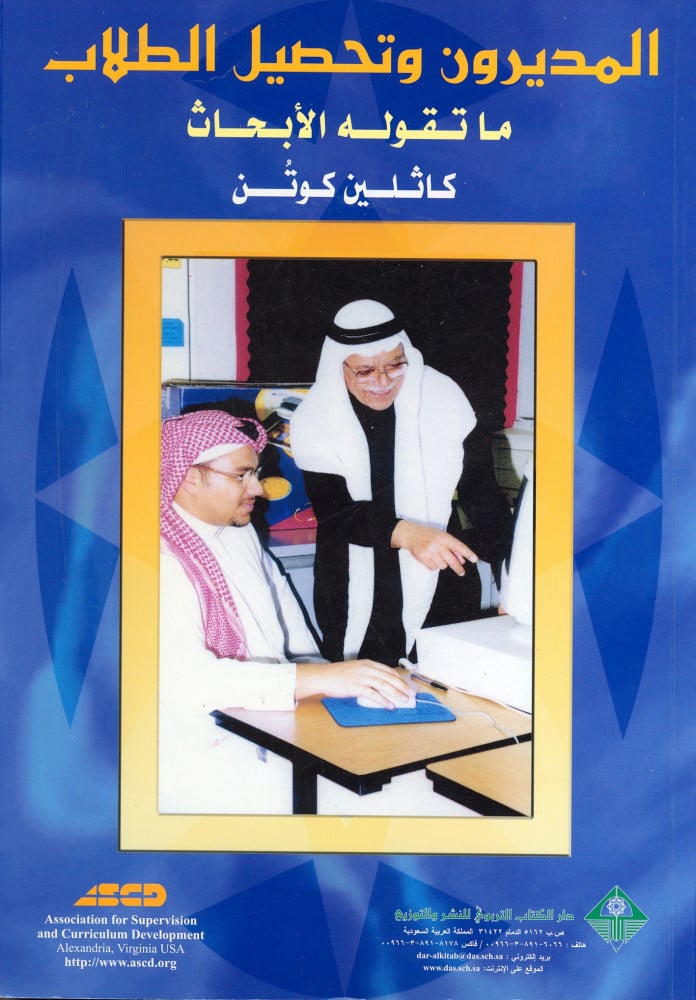AVAILABLE IN ARABIC
About This Book
What are the direct and indirect influences of principals on student achievement? How do successful principals motivate others? What kinds of relationships do they have with parents, students, and staff?
Principals and Student Achievement identifies 26 essential traits and behaviors of effective principals to show how they achieve success as instructional leaders. Based on a review of 81 key research articles from the last 20 years, this concise book examines how certain practices can affect student achievement, including:
* Communication and interaction
* Classroom observation and feedback to teachers
* Recognition of student and staff achievement
* Dedication to a safe and orderly school environment
* Support of professional development of staff
* Role modeling
The book also reviews differences in instructional leadership between elementary and secondary principals, male and female principals, principals in high- and low-socioeconomic-status schools, and more.
We all know that principals are important to student success, but few people have pinpointed exactly how they make a positive difference. At a time when principals are being asked to do more for school reform and accountability, Principals and Student Achievement provides a valuable resource for identifying what it takes to be an effective principal and, in turn, an effective school
Topics : Leadership
Table Of Content
Preface
Introduction
1. Research Findings about Principal Behaviors and Student Achievement
Safe and Orderly School Environment
Vision and Goals Focused on High Levels of Student Learning
High Expectations for Student Learning
Self-Confidence, Responsibility, and Perseverance
Visibility and Accessibility
Positive and Supportive School Climate
Emotional and Interpersonal Support
Parent and Community Outreach and Involvement
Rituals, Ceremonies, and Other Symbolic Actions
Shared Leadership, Decision Making, and Staff Empowerment
Collaboration
Some General Findings about Instructional Leadership
Outgoing Pursuit of High Levels of Student Learning
Norm of Continuous Improvement
Discussion of Instructional Issues
Classroom Observation and Feedback to Teachers
Support of Teacher Autonomy
Support of Risk Taking
Professional Development Opportunities and Resources
Protecting Instructional Time
Monitoring Student Progress and Sharing Findings
Use of Student Progress Data for Program Improvement
Recognition of Student and Staff Achievement
Role Modeling
What These Principals Don't Do
2. Other Key Research Findings about Principals
The Leadership of Male and Female Principals
Elementary and Secondary Principals
Principals in High- and Low-SES Schools
Principals' Impact on Student Outcomes
Transactional and Transformational Leadership
Effects on Principals' Leadership
The Dearth of Instructional Leadership
Developing and Improving Principals' Leadership
Summary
A Special Tribute
Annotated References
About the Author
About the Authors
Cathleen Cotton:
Kathleen Cotton was a Research Associate with the School Improvement Program of the Northwest Regional Educational Laboratory (NWREL) and the author or coauthor of more than 70 publications. From 1987 to 1996, she coordinated the development of the School Improvement Research Series, a collection of syntheses of educational research literature on topics of current interest and feature articles showcasing exemplary school programs from around the United States. Her research summaries identified effective practices in many topic areas, including citizenship education, employ-ability skills, the education of urban minority youth, thinking skills, schoolwide and classroom discipline, early childhood education, and parent involvement.
Cotton also published papers on the effects of school size, teacher expectations, multi-age grouping, and other topics. She authored a general research synthesis and a best practices synthesis, as well as two books copublished by NWREL and ASCD: Research You Can Use to Improve Results (1999) and The Schooling Practices That Matter Most (2000). She has been quoted about her research on school size in dozens of U.S. newspapers, as well as Time magazine and the Utne Reader. Her B.A. from the University of Oregon and M.A. from Portland State University were both in English.
ISBN: 9960863263
Author: Cathleen Cotton
Publisher: Educational Book House
Size: 16*23cm
Pages number: 147













